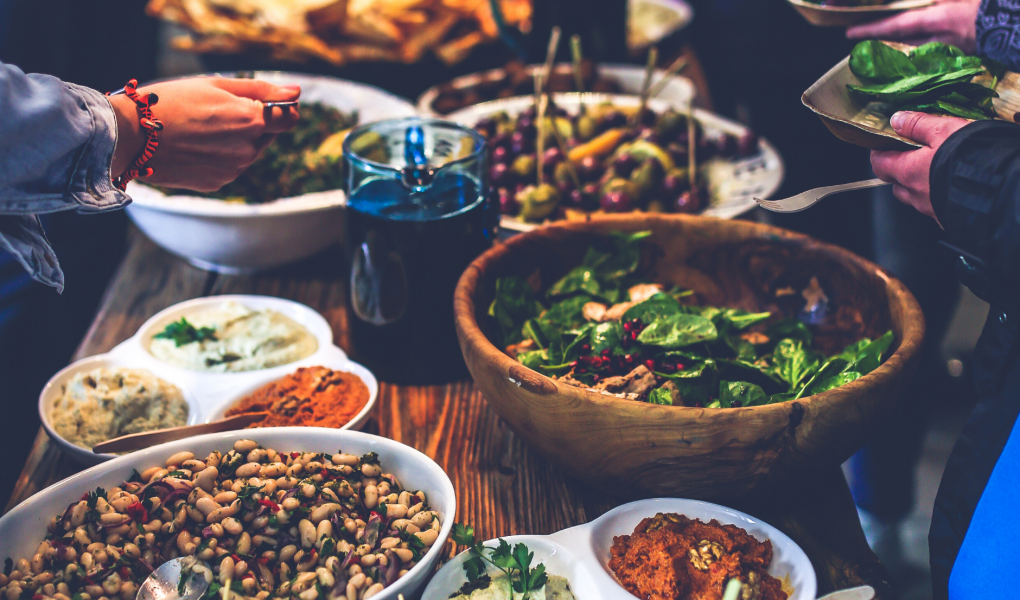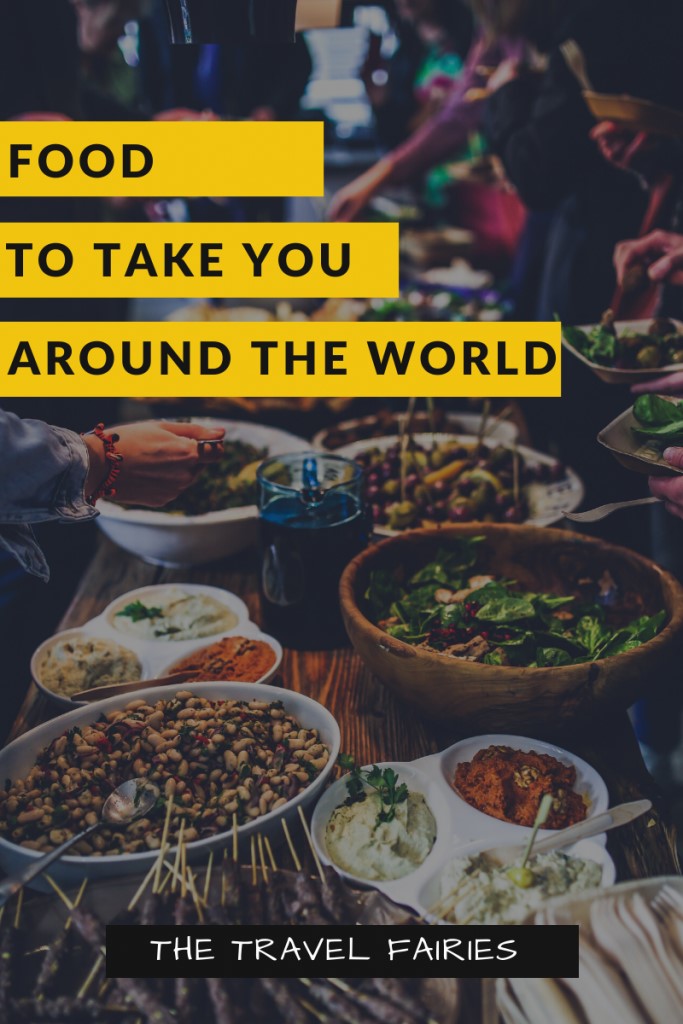If you’re travel obsessed like me, it can be very difficult when we can’t travel. Always dreaming of that next destination but it’s just out of reach. So instead, we must come up with new ways to travel without leaving home. One way we can do this is to travel through food by recreating popular dishes from around the world to give you a sense of these trips you have previously taken or will take in the future. To help me with this, I asked a few fellow bloggers to write about the food, drinks, meals and snacks that will always remind them of (and immediately take them back to) a certain country they have lived in or visited. Read on to see all their suggestions and hopefully you will join us in traveling through food too!

Belgium
One of the best parts about my trip to Belgium has to be the food there. Belgium is well known for several delicacies including, waffles, chocolate and beer. One of the lesser-known foods that Belgium claims to have invented is French fries, despite the name. The story is that the people in the region were frying up small fish that they caught in the rivers but when these rivers froze up over the winter they would instead fry potatoes cut into thin strips. The name French fries only came about as it was the French that introduced them to America. In Belgium they are known as frites and often served with mussels. Some would even go as far as to say moules frites (mussels with fries) is the national dish of Belgium.
Moules frites can be made very easily at home so long as you have access to mussels and potatoes. Simply cook the mussels in a sauce made of garlic, parsley, white wine and spices, herbs or vegetables of your choice, remove the mussels from the sauce and thicken it with cream before pouring it back over the mussels. Prepare the fries however you normally would, freshly cut potatoes fried is best but even frozen oven chips make for a great dish and serve the mussels and fries together.
For dessert, a Belgium waffle is a must. These sweet doughy treats can be served with melted chocolate, cream, ice car, syrup, fruit or pretty much any topic you can think of. In Belgium, you can find them around every corner and I had one every day of our trip but still never managed to take a picture of one as they were too good that I couldn’t wait to try it! They are easy to make yourself with eggs, flour, sugar, butter and milk but do require a waffle iron to get the characteristic pattern. You can, however, usually find premade versions in most supermarkets that you can then customise yourself.
To finish off, have a box of Belgium chocolates and wash it down with a Belgium beer and you’d never believe you weren’t in the country itself!
Amy from The Travel Fairies
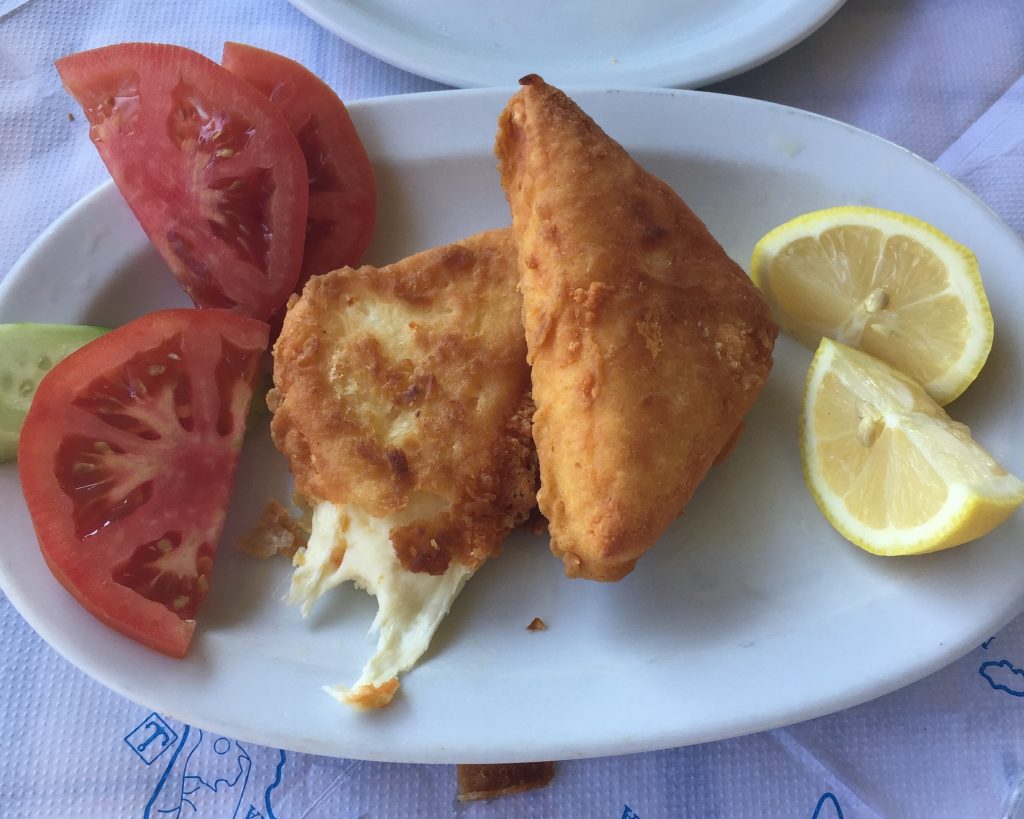
Greece
After spending an unbelievable ten days following a Greek island hopping itinerary, we take any chance we can to remind ourselves of the fun and food we enjoyed. When we get a bout of travel nostalgia for Greece, we head out to a Greek restaurant and try some of our favourite foods from the trip.
We always begin the meal with saganaki – just like we did in at almost every meal in Greece. It’s a delicious piece of cheese that’s pan-friend in olive oil and served hot. It’s also perfectly delicious in every way. Cheese is always a winner with us, but the Greek saganaki is utterly divine. It is our appetizer of choice and it’s best served with a squeeze of fresh lemon juice.
The other Greek dish that we make sure to order is suvlaki. It’s common enough to find in most cities around the world and even in street food carts. Souvlaki consists of small pieces of meat and vegetables skewered and grilled. Vegetarian options also exist. They’re prepared with meat analogue or you can order a skewer of grilled vegetables alone. Suvlaki is eaten hot, sometimes still on the skewer and served with fries or in a pita. We had suvlaki in Athens and on every island we visited in Greece.
Our favourite drink, which we started every day with, is a frappe. It’s the Greek version of iced coffee that’s easy to recreate at home. The drink is simple, consisting of instant coffee, water, ice and sugar. It’s blended and can be found almost everywhere in Greece. It was what someone recommended to us on our first ferry and we drank them everywhere we went. Now we enjoy them in our kitchen at home and it takes us right back to Greece.
Derek from Robe Trotting

Ireland
Dishes that take me back to Ireland instantly are colcannon, white pudding and Irish stew. They are some of the best foods from Ireland and two can be made at home very easily.
Colcannon is often known as a left-over dish. It is comprised of mashed potato and cabbage, and in our house, is typically served with boiled ham. It may sound like a strange or weird combination, but it is a homely dish that instantly transports myself and my husband back to our days as children in Ireland. It is often a next day dish and it has been known for us to eat it at breakfast with some Irish sausages, rashers and white pudding.
Another dish that is a very homely Irish dinner is an Irish stew. It used to be made with mutton as the meat, alongside potatoes and onions, but nowadays it is typically made with lamb. For families who aren’t fans of lamb, beef can be substituted, but that makes it less of a traditional Irish stew. Carrots are often an addition along with herbs such as thyme, rosemary and bay leaves (at least in our house). It is a hearty winter dinner and is another dish that takes us back to the homeland.
Another food item that is something we often covet living away from Ireland is white pudding. While black pudding is often part of a full English breakfast, for us, a full Irish has to include white pudding. It is essentially the same as black pudding minus the blood part of the ingredients and is one of a handful of items we ask family to bring with them when they come to visit us, as it is not readily available in shops in Portugal. There is nothing like an Irish breakfast after a member of our family has visited.
Cath from Travel Around Ireland
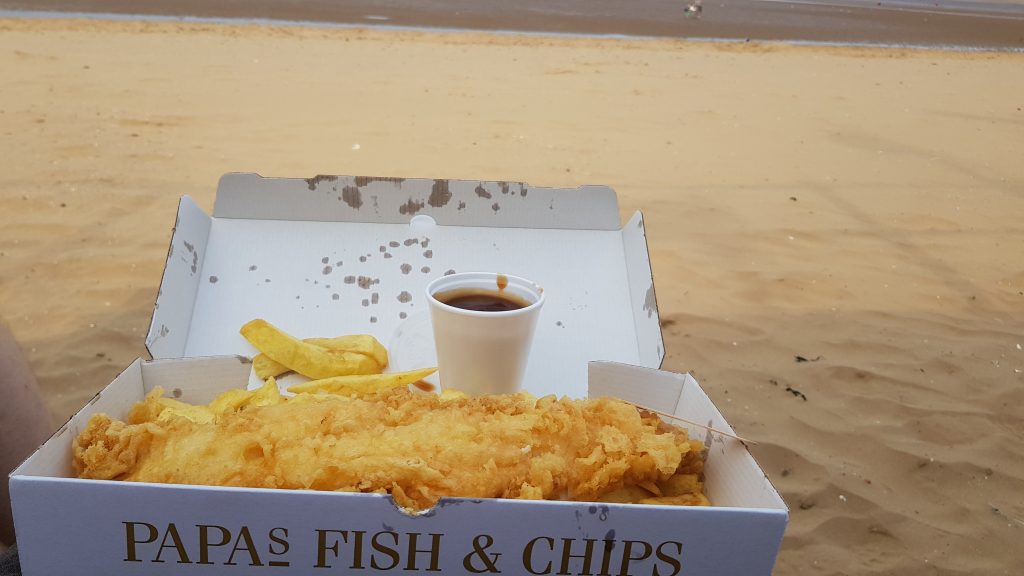
England
Nothing beats proper fish and chips from a proper fish and chip shop in England. Preferably from a fish and chip shop on the coast. I can strongly recommend a day out in Portsmouth, where I live on the south coast, to sample the best of England’s chip shops. We have 14 here, all serving their own take on what I consider an English delicacy.
Each area of England takes their fish and chips differently. In the north they like it with gravy, mushy peas and bread and butter, while In the south it’s all about the ketchup, mayo and curry sauce. I’m from the Midlands and so anything apart from mayo is standard for me – as long as there’s lots of salt and vinegar!
If you’re really going all out, then you can add a saveloy sausage as a side to your fish and chip supper. They’re not really seen as the height of chippy culture, but they’re delicious. Especially the battered ones.
The typical thing to have to drink with fish and chips is a cup of tea, but if you’re dining in the evening then I’d recommend a nice glass of chilled Sauvignon Blanc at a restaurant or at home. If you’re just eating them on the beach – the best way to eat fish and chips – then get a few cans of cider to wash them down with from the shop.
You can buy frozen battered fish in all supermarkets in England, but you’re going to need a deep fat fryer to get the authentic chippy taste. And only freshly cut potatoes will do for the chips.
One last tip for your fish and chip dinner – we all know the vinegar goes on before the salt, don’t we? Gotta give those salt flakes something to stick to!
Vicky from Day Out in England

Italy
Pizza, Pasta and Wine are three things that instantly remind me of Italy. Throw in some old Italian classic music and there you have it, your mini trip to Italy right from your home. Most evenings I make myself an easy Italian style Pizza and bring out a bottle of Italian wine to go with it. On other evenings, I whip up a quick Roman style Carbonara and play ‘Volare’ or ‘That’s Amore’ on full volume and let my senses travel to Italy. Luckily Italian cuisine is all about simple and fresh ingredients making it easy to whip up anywhere in the world.
This reminds me of my past trips to Naples, the city where the Pizza was invented. And lining up in those typical Italian style streets of the city just to get a table at the famous Sorbillos Pizzeria. Or of those countless evenings in Rome where I would hunt for that perfect dish of Carbonara. And the times I would walk around the streets of Trastevere with a glass of Italian wine or Prosecco.
Food has such a way of taking us back to those beautiful places and beautiful memories!
Merryl from Merryl’s Travel & Tricks

Vienna
While Vienna sausage is known to be a food named after Vienna, it is difficult to find those canned version in the city. What Vienna, and Austria as a whole, offers is what is known as Frankfurter, parboiled sausages. Hilariously, these sausages are called Wiener (German for Viennese) in Germany, where Frankfurt is a famous city. ^_^ These sausages are staples in Austrian restaurants and heurigers (taverns) usually with a side of potato salad. There is a wide range of these sausages that can be bought from street stands and Vienna’s markets.
But, if there are dishes that Austria could be identified for, Tafelspitz and Wienerschnitzel would be on top of the list. Both dishes are from veal (calf meat), which is much tender than beef. Tafelspitz is a simple dish of boiled beef. The cut used for this dish is simmered along with root vegetables and spices in broth, served with potato roasts, horseradish, and sometimes sour cream. It’s very simple but it was Emperor Franz Joseph’s staple. Wienerschnitzel could look familiar – breaded cutlet, tonkatsu, cotoletta, or escalope are some of its name in other countries. What differentiates Wienerschnitzel is the use of veal, thinned with a kitchen hammer. And this is protected by law, only those made from veal can be called Wienerschnitzel and restaurants are required to identify if they are not using veal (chicken, pork, turkey schnitzel). This dish is usually served with a slice of lemon, and potato salad.
And for sweet-toothed people, the apple strudel (Apfelstrudel) is something I prefer over Sachertorte anytime.A strudel filled with apple slices, cinnamon, and sugar baked to perfection. It’s the best comfort food to end your day with after walking around Vienna’s beautiful, nostalgic streets.
Marie from Our City Travels
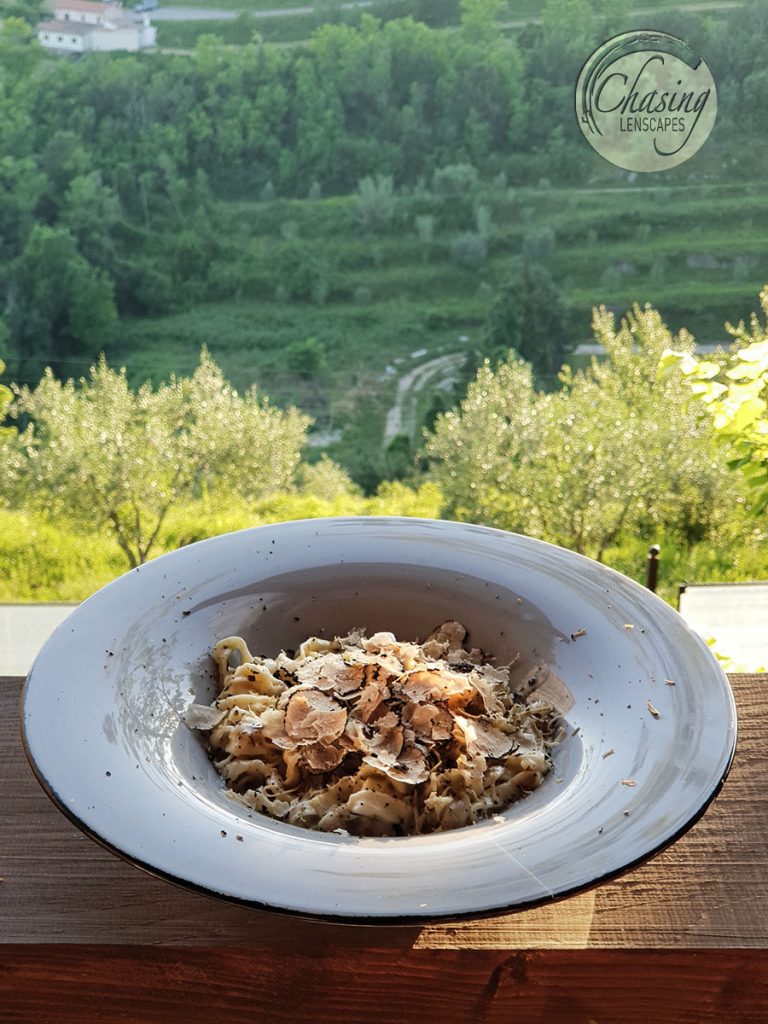
Croatia
Planning our trip to Croatia was not an easy task. We had to fit into our 2-week Croatia itinerary so many attractions and adventures. From stunning historical sites and gorgeous waterfalls to beautiful islands and breathtaking views, we wanted to see everything Croatia had to offer. Our Croatian adventure was perfect, filled with history, culture, stunning views, and lots of food! The richness of the Croatian cuisine took us by surprise. Many cultures have influenced the local cuisine over the years, and therefore, in every part of Croatia, you’ll find a variety of traditional dishes made from local and fresh ingredients.
Our favorite part of Croatia was probably the Istrian Peninsula, a foodie paradise and a true hidden gem. Other than gorgeous beaches and small ancient towns, you’ll find here wineries, olive oil groves, and lots of truffles. Istrian cuisine is all about pasta, polenta, seasonal ingredients, and truffle, of course. After we’ve had so many excellent truffle pasta dishes all around Istria, truffle pasta will always remind us of the relaxing Istrian atmosphere and the delicious Istrian cuisine.
Seafood is another fundamental ingredient in Croatian cuisine, especially along the coast of Croatia. One of our favorite dishes was octopus salad. Every restaurant seems to have its own version of this delicacy, but all of them were delicious and included octopus, some vegetables, herbs, and sometimes potatoes. We’ve eaten so many of these along the coast of Istria and Dalmatia. It’s the perfect appetizer during the hot summer days.
Our third favorite food from Croatia is the famous Croatian burek, which can be found in many regions in Croatia. You can find a similar version of this doughy pastry in many countries in the Balkans and around the Mediterranean. The Croatian burek is prepared with thin and flaky dough that is filled with either meat or cheese. We’ve only tried the cheese version and loved it. Carb-lovers, this is the dish for you!
Croatia has a wonderful food culture that has been influenced by its rich culture and history. There are so many tasty local delicacies to try, but these were our favorite Croatian dishes that will always remind us of our wonderful Croatian vacation.
Maya and Sari from Chasing Lenscapes

Romania
Sarma is a dish common throughout the Balkans. They came here by way of the Ottoman Empire and became a staple in many countries.
Greeks have the dolmades (sarma in vine leaves), Romanians and Hungarians have the cabbage rolls.~
Traditionally eaten at major holidays – “sarmale” (cabbage rolls) – are typically filled with a mixture of rice, meat, and seasoning. Preparing the dish takes quite a bit but only because you need to roll the mixture into the cabbage leaves.
During Lent, a vegan version of the sarmale is cooked. Most often, it includes white rice, mushrooms, onions, carrots, and seasoning. However, each region in Romania adds its own touch, whether it’s about the ingredients or the cooking process.
I’m born in Transylvania and have extensively traveled in the area, too. Our sarmale are most often boiled on the stovetop. Sometimes we pair them with mamaliga (polenta).
To make sarmale, start with taking the cabbage head from the brine and let it stay in some cold water. Meantime, in a pan, lightly cook 2 large onions cut into cubes and 1 kg of mushrooms, also cut into cubes. Cook about halfway through and let it cool down. While it cools, separate the cabbage leaves and put them in a sieve to let the water drain. Now, take that mincer out and mince the onions and mushrooms. Grate a medium carrot and, in a pan, add 1 cup of rice, the onions and mushrooms, the grated carrot, salt, and pepper. I also add ½ cup of tomato juice (or a grated tomato) alongside 2 cups of water. Cook until the water evaporates. Let it cool.
Then take a large pot. On the bottom of the pot, add some cabbage cut into strips. On top, add some bay leaves, dill and whatever herb you like (I prefer oregano, others add thyme). Then start rolling the sarmale and stack them in the pot. Cover with some more cabbage and water then add the lid on top. Boil on low to medium for at least 45 min. Serve with polenta (or bread) and hot pickled pepper.
Cris from LooknWalk

France
I frequently find myself recreating some of the incredible meals we had last time we were in Paris.
One of my favorite classic, but easy to throw together, French meals is Chicken au Jus with Herbs de Provence. Au Jus simply refers to a light gravy made from the juices of the meat. In French cooking, it’s a basic way to enhance an already flavorful dish and bring out some of the more subtle flavors.
Simply pan roast chicken, preferably in a cast iron, that’s coated in a little flour and Herbs de Provence and set it aside. After the meat cooks, deglaze the pan (with the drippings still in it) with a little oil and toss in some garlic and onion. Add in some stock, bring to a simmer, and let the sauce reduce a few minutes before removing it from the heat. If I want to thicken the sauce a bit more, or add another dimension, I’ll melt in a tablespoon of butter and spoon it over the chicken. Instantly, we’re transported back to France, where food is fresh, flavorful, and deceptively simple.
Another easy to recreate favorite is ham and Swiss on a baguette with butter. The trick with this Parisian classic is to use quality ingredients, especially the bread. Instead of grabbing a grocery store baguette, find a local baker and get it fresh. I love lightly toasting the baguette, then adding ham, swiss, and a generous spread of European butter. Within minutes, we’re picnicking on the banks of the seine.
Round out your meal with a glass of French wine. A Provencal Rosè or crisp Viognier are some of my lighter favorites. For a heavier meal, like the Chicken, crack open a bottle of Bordeaux. Don’t forget to serve French cheese for dessert!
Tori from Tori Leigh
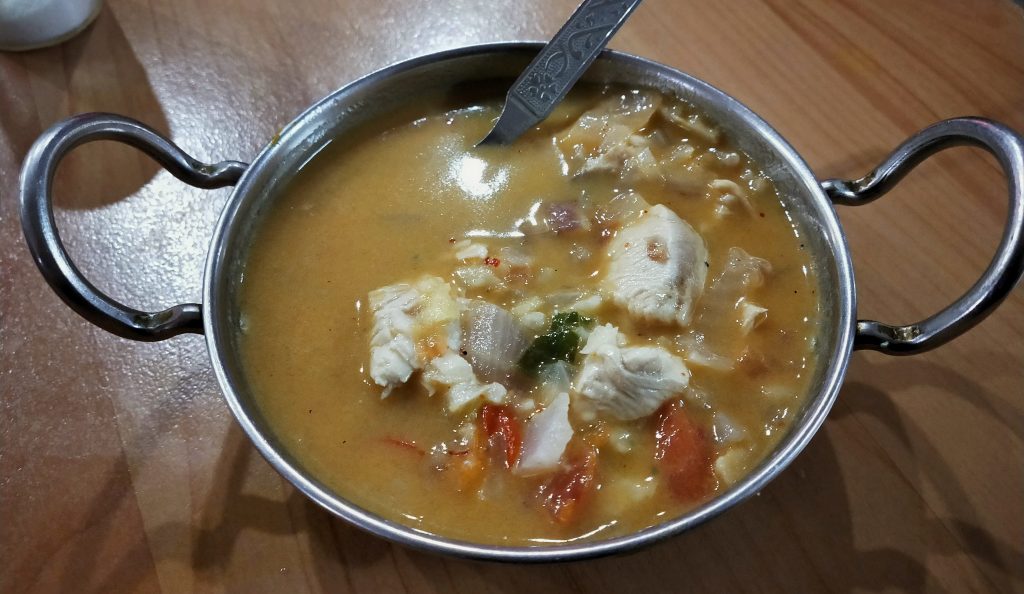
Bhutan
Bhutan, known as the Land of the Thunder Drangon or the Last Shangri-La, is home to some of the most unique foods we’ve ever tasted. They love spicy food and it may be very often be difficult for foreigners to get accustomed to that much spice! The Jasha Maroo is my most favorite dish from my trip to Bhutan. This soupy Bhutanese style chicken stew is full of flavors and is a killer combo with rice. It is very easy to make at home, and takes just under 30 minutes to prepare! Another unique Bhutanese dish is the Ema Datshi, the National dish of Bhutan. Made of chillies and cheese, the Ema Datshi is one of the most interesting foods to taste. It’s a common everyday dish for the people of Bhutan, and one of the must try things when you visit this country. Other variations of this dish can also be made with mushrooms and potatoes as well. The Bhutanese people love to start their day with a cup of their beloved butter tea called ‘Suja’ which is essentially tea made with tea leaves boiled in water, butter and salt! This is more like a soup than tea, and is definitely a taste you would never forget. The suja used to be made using yak butter in the earlier days, but now mostly normal cow’s milk butter is used since its rare to find yak butter. Bhutan gives you many beautiful experiences when it comes to travel as well as food.
Neethu from Our Backpack Tales
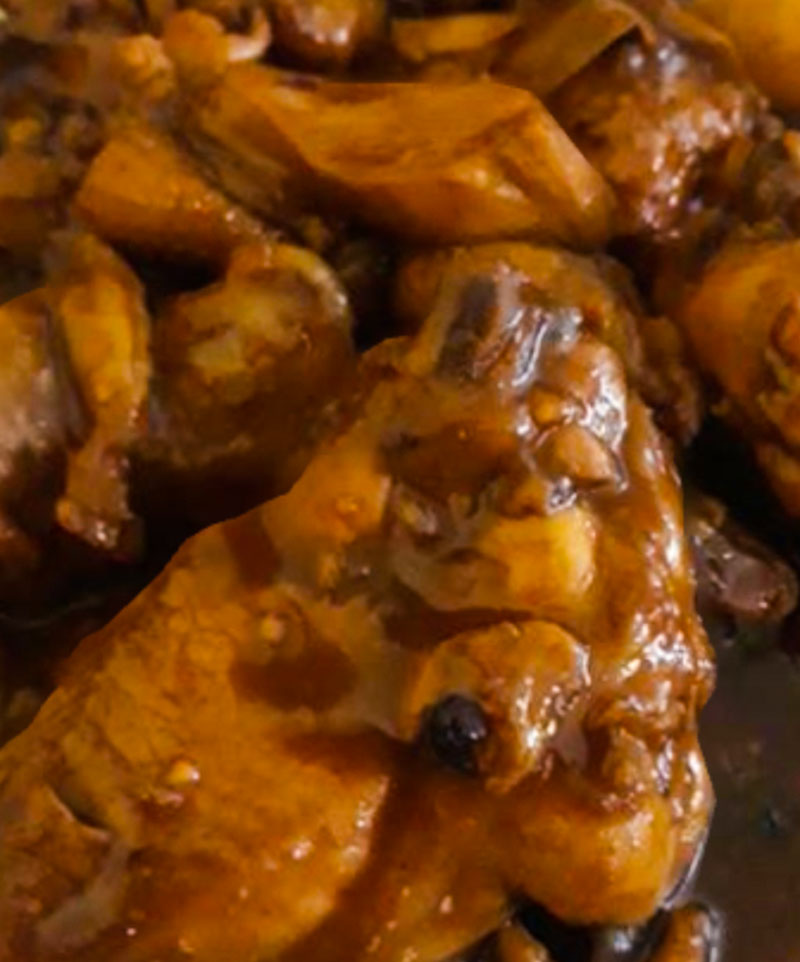
Philippines
If one got a chance to meet a Filipino and dine at her home, there is a great chance that she would serve you an adobo dish – right from her pantry or dig from her refrigerator. This is a situation if the dine-in is unplanned.
If everything is all prepared before you come to a Pinoy’s house and the host wants you to taste a real Filipino dish, then, definitely, there would always be a Sinigang and, of course, Adobo.
These two dishes are both trademarks of Filipino cuisine.
Philippine Adobo is a soy-sauce based viand. Its ingredients are so easy to find on your kitchen cabinets. Those are blends of soy sauce, vinegar, garlic and peppercorns. These condiments will be the marinade of your choice of meat.
After several hours of marinating, you can heat oil and sear the meat. Then pour the marinade and let it simmer until the meat is tender enough.
It was so simple to make.
The juiciness of the meat with its very tasty sauce spooned on top of rice makes a perfect lunch, but greater for breakfast and such a feast for dinner.
The famous Sinigang na Baboy, or Sinigang na Hipon, is a tamarind-base soup exploding sourness that results on one’s refreshness. Yes, it is true.
You will sip and slurp the soup. Then, munch on your choice of meat or seafood. After that, start crushing the green leafy vegetables on your mouth. All these will be accompanied with perspiration from the heat of the chilli peppers. And a few minutes more, splash of freshness would be felt together with the thankfulness whoever invented the Sinigang dish.
Sinigang is easy to do. You need a tamarind mix that is readily available on the nearest store or supermarket. With lots of water, some onions and tomatoes, pour the mix powder, add your meat or seafood and boil until tender enough. Then, throw your leafy vegetables and chilli peppers. You can add radish and string beans. Let all boil for a few minutes, and that’s it! A very satisfying dish will be served.
Now you know what to look forward to. Aside from Filipino’s sweet smile, there exist the best adobo and sinigang that are very worth for your taste buds.
Elsa from Travelling Quote

China
Eating spring rolls, wonton soup and fortune cookies remind me of China. Spring rolls are usually eaten during the Spring Festival in China. The golden spring rolls represent gold bars, which symbolises wealth. Wontons originated in northern China; over time they became popular in southern China, which developed a distinct wonton style.
Both spring rolls and wontons are made differently in the various China regions. A variety of fillings are used. They are cooked using various methods – fried, steamed, and boiled (wontons only). The shape and size are different – spring rolls can be long, short, wide, thin; wontons can be triangular or circular.
Fortune cookies are little after dinner desserts with messages inside. They actually originated in the United States of America, not China. But they are served in a lot of Chinese restaurants around the world. Even though this is the case, they still remind me of China.
Spring rolls, wonton soup and fortune cookies, or their ingredients, can be readily purchased from a regular supermarket, which is great. With an entree, main and dessert, dinner is sorted.
Spring rolls can be found in the frozen food section, and just need to be baked in the oven. Fortune cookies are ready to eat out of the box. They are usually located in the Asian food or biscuit aisles in the supermarket.
For wonton soup, you usually need to buy the ingredients and make them yourself at home. For the wontons, buy wonton wrappers, pork mince, egg, soy sauce, sesame oil, shrimp, carrot, and chives. To make a simple soup, you will need chicken stock and bok choy. Making your own wontons is relatively easy, but takes a bit of time. Usually about an hour in preparation and cooking time if you make the whole pack of wonton wrappers.
China is one of the best places to travel with a baby in Asia, as a couple or solo. When you’re next eating spring rolls, wonton soup and fortune cookies, you can daydream about planning your next China trip.
Clara from Petite Capsule

Uzbekistan
Uzbekistan was once part of the ancient Silk Road where traders with their camel caravans from all over the world passed through. This time of wealth resulted not only in the beautiful Islamic architecture you see in cities like Samarkand, Khiva and Bukhara, but also in a rich cuisine that is influenced by different cultures.
The number one dish in Uzbekistan is plov. A Persian rice dish with carrots, onions and meat. It is everywhere and always served with fresh bread from the oven and tea. In the most popular restaurants, you can see huge cauldrons where the plov is cooked and stirred to perfection.
As a traveler you might think plov is all there is, but there is much more to explore in Uzbekistan. There are filling soups and hearty stews like laghman introduced from china or dimlama introduced from Turkey. The nomads from Kazakhstan and Kyrgyzstan brought with them horse meat that is a priced delicacy and found its way in Noryn. A typical Uzbek cold noodle salad with minced horse meat.
One of my favourite Uzbek dishes is actually more of a snack. Samsa’s are filled dough pastries baked in a traditional clay oven called a tandoor. At the bustling bazaars you will often smell them before you see them. Fresh from the oven they are absolutely delicious and they only cost you a few cents. The most common filling is meat, but you will also find vegetarian ones with potatoes.
While most Uzbek dishes are unfortunately not easy to come by once you are at home, Samsa’s are relatively easy to make yourself. All you need is an oven and puff pastry, minced meat, onions and some spices like cumin. Before you know your home will smell like Uzbekistan.
Ellis from Backpack Adventures

Vietnam
Vietnam is a special place for us. It is Anh’s home country and we make a trip there every year together.
On our last trip we made a point of trying a new Pho every morning in Hanoi. The diversity of flavours for this simple dish made every day a new experience!
I never thought a noodle soup would be a breakfast I would look forward to, but I adapted very quickly.
This is a staple dish that Anh cooks for us regularly but it had only ever been a dinner option up until this point.
For breakfast a soup just wasn’t hearty enough to keep me going for long. So we would follow up with banh mi that had egg as the primary filling instead of the usual pork or chicken.
This tasted a bit more familiar to a western breakfast, but still with some local flavour twists like pate and cucumber for fillings that are consistent with a banh mi that I might find at home.
Sticking with the breakfast theme, the other Vietnamese indulgence that we have persisted with at home a unique spin on a morning coffee.
Rather than adding in milk & sugar, they serve an egg coffee. This has a black coffee base with a foamed egg yolk sitting on top.
While this sounds disgusting at first, it is mixed with condensed milk to create a light and sweet foamy topping which is surprisingly addictive.
I am spoilt by the fact that Anh is an excellent cook! To her these dishes are just normal daily for foods.
For me, an exotic indulgence… And not a week goes by where we do not eat or drink at least one of these.
James and Anh from Team AJ Travels
Oman
There are three Omani snacks that were important during my trip around Oman. The first is Omani Chips. Although these aren’t classified as a proper dish, the Omani people are incredibly proud of these bags of locally produced fried potato bites. Many of my friends were ecstatic to know that I’ve tried the chips and these little red bags were a constant during our road trips around the country.
The second is Mishkak. Mishkak is a very popular street food that consists of marinated and grilled meat. One of the best things to do in Muscat is heading to its night markets for a bite or three of mishkak! Not only is it delicious, but mishkak is also easy to make. Whether it be lamb, shrimp, or steak, simply soak it in a combination of spices, including cumin, garlic, pepper, cayenne pepper, and cinnamon. Let it sit for half an hour and skew the pieces onto a stick. Put it over the grill and within a few minutes, you will have a delicious meal.
Lastly, the Omani burrito is a popular camping snack that combines the two things mentioned above. It’s extremely easy to make. Simply grab a few pieces of flatbread, a spoonful of mayonnaise or some cream cheese, and a bag of Omani Chips (substitute another brand of chips if you prefer!)
First, spread the mayo or cheese on top of the flatbread. Afterward, crush and sprinkle the chips of top of the bread. Lastly, you can spice the semi-burrito with a few pieces of mishkak or some fried eggs. Roll it up and voila, you have a common Omani camping treat in front of you!
Oman is known for its fresh juices. Squeeze a few oranges into a glass to accompany any of the snacks mentioned above.
Daisy from Oman Travel Guides
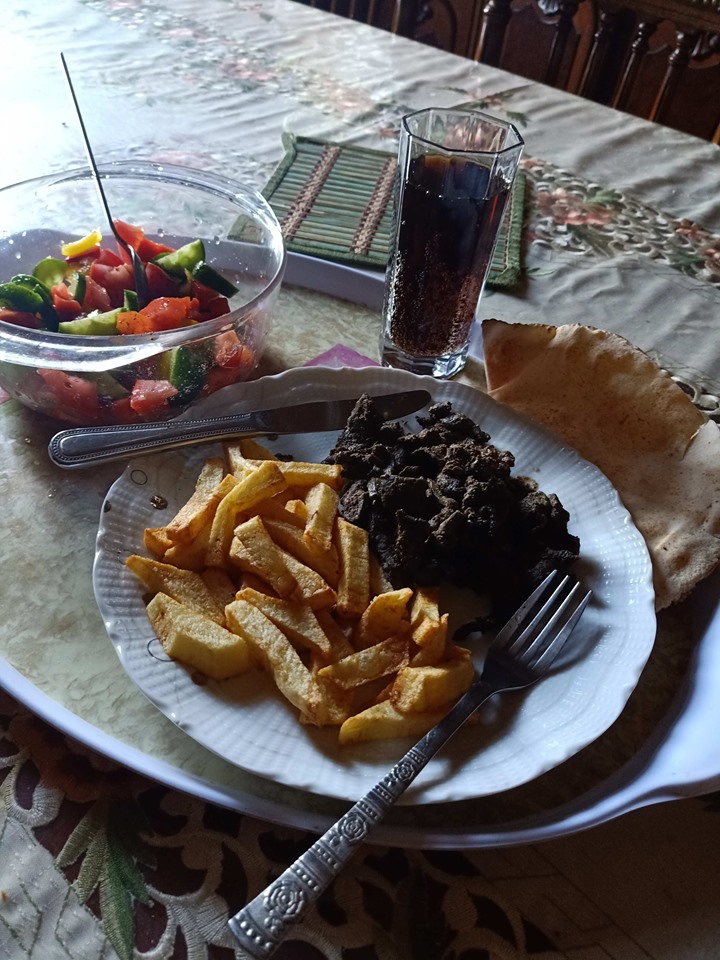
Egypt
The reason why I chose my homeland, Egypt, was because Egyptian cuisine is very underrated internationally, even though it’s one of the best Middle Eastern kitchens. A major element of any trip to Egypt is the food, especially the street food, that’s why I thought about three dishes that are both delicious and can be easily recreated at home.
Let’s start with breakfast, and for that, I’ve chosen taa’meya (Egyptian falafel). Everyone loves falafel, right? But why is the Egyptian one so special? It’s because it’s made of fava beans, unlike the Levantine falafel which is made of ground chickpeas. To make your own, place 2 cups of dried split fava beans in a large bowl covered with water and let it soak overnight for 8 hours. After draining in the morning, marinate with red onions, parsley, cilantro, garlic, coriander, salt, and cumin; use a food processor till you get a dough-like mixture. Shape into flattened balls and cover in toasted sesame seeds, then fry until golden brown.
Moving on next to my favorite hometown specialty, Alexandrian liver. Cut the liver into shredded pieces, marinate with fresh garlic, chopped green pepper, and salt and pepper. Cook in a pan and towards the end, add some lemon juice, then serve in pita bread sandwiches.
Another dish I really like is called hawawshi; which is some sort of beef pie. There are two ways to make it; the Alexandrian way and the Cairene way. The Cairo folks place the marinated ground beef in Egyptian baladi bread then cook in the oven, while Alexandrians bake the bread themselves. You can use a pizza dough recipe and stuff it with ground beef, marinated with chopped tomatoes, onions, parsley, and salt and pepper.
Bel hana wel sheffa! (Egyptian for “enjoy your meal”)
Nadine from Curls en Route

Hawaii, USA
Hawaii is a truly special place – ask anyone who has been there. Once you have been, you never stop thinking about going back. Until we can go back, a great way to feel a little closer is to snack on something that reminds you of being there! Hawaii has a range of amazing food to try; the garlic shrimp from the food trucks on the North Shore, Poke bowls, fresh coconut and amazing seafood. Visitors are spoilt for choice in this beautiful place!
Dole is famous worldwide as a brand of canned pineapple, and there is a good reason! Incredibly delicious, not many people are aware that this yummy little morsel is from Hawaii. Visitors can actually travel to the pineapple plantation on Oahu, and Dole is available across the island, both in cans and as ‘Dole whip’, a mouth-watering, dairy-free, pineapple flavoured ‘ice cream’. Look out for the truck at the bottom of the Diamond Head hike – a perfect cool treat after a sweaty walk!
Spam is available all over the world, and is a canned meat product that became popular after World War 2. Why does it remind me of Hawaii? Hawaiians are notorious for their love of Spam, and it is often called ‘Hawaiian Steak’. There is even a festival every year to dedicated to the canned cuisine, and many Hawaiian recipes have extended to include Spam, including sushi, and it is even available as part of a McDonalds breakfast. On our first visit to the supermarket, we were shocked and delighted to see the number of varieties of Spam on offer; indeed, there was almost an entire Spam aisle! It is now something we will always associate with Hawaii and our time there.
The climate of Hawaii is fantastic for many reasons, but one of them is the foods they can grow year-round, like yummy Macadamias! And if that wasn’t already good enough – they cover them in chocolate, and sell them just about everywhere. Usually, due to their seasonality, chocolate-covered Macadamias are expensive. However, in Hawaii, they are easy to find, and even more delicious for their freshness – there are also several plantations to visit, where you can buy (and sample!) a huge variety of Macadamia products. Lucky we were so active on our trip, otherwise the amount of chocolate Macadamias we consumed would have quickly become a problem!
The best thing about all of these items is that they are all easily available at your local supermarket! You can try making your own ‘Dole Whip’, fry up some Spam with your eggs, or cover your own Macadamias in chocolate! Go and taste a bit of Hawaii for yourself – you’re welcome.
Jenna from I know the Pilot
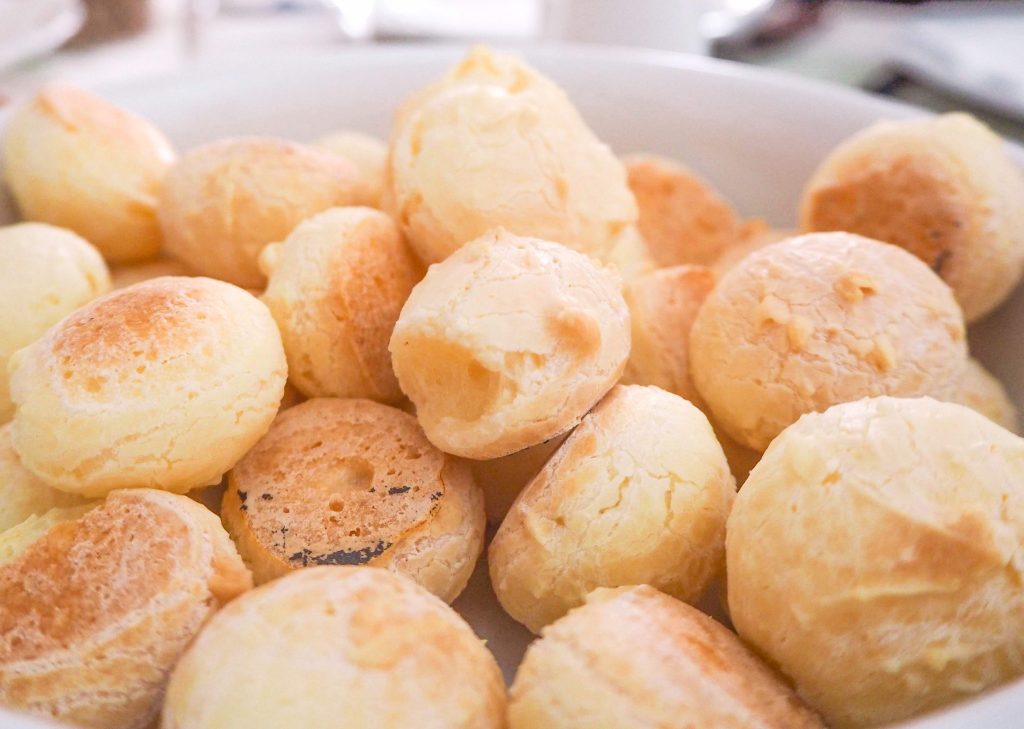
Brazil
Brazil is not particularly known for its food. That’s why I was genuinely surprised by the abundance of incredible local dishes and the diverse cuisine when I visited the country in 2019. From hearty stews to beautiful desserts, from exotic fruit smoothies to mouth-watering street food, the range of options was immense and deciding what to eat was a challenge in itself!
I’ve picked three of my favorite Brazilian foods which I frequently recreate at home. Indulging in these dishes takes me back to the time I spent in São Paulo and Rio de Janeiro exploring the streets, enjoying local cuisine and experiencing the unique culture of Brazil.
Tapioca crepes, a popular street food, are thin white pancakes with a chewy texture. Made with just tapioca flour, a splash of water and a pinch of salt, they are naturally gluten-free and can be served with a variety of toppings such as butter, cheese, ham, bananas, coconut, chocolate, or strawberries. My personal favourite is a tapioca crepe with condensed milk and bananas.
Another snack that I can’t get enough of is the Brazilian cheese bread or pão de queijo. Just like tapioca crepes, pão de queijo is gluten-free as it’s made with tapioca flour which is mixed with eggs, oil, milk and grated cheese. After rolling the dough into small balls and baking them for 30 minutes, you’ll end up with a tray full of golden little puffs that are crispy on the outside and chewy and cheesy on the inside.
Last but not least, I want to highlight brigadeiros – a Brazilian version of chocolate truffles. These heavenly treats are made by mixing condensed milk, cocoa powder and butter. The mixture is shaped into bite-sized balls which are then covered with chocolate sprinkles. Brazilians have a notoriously sweet tooth and brigadeiros are the perfect example of this so get ready for a sugar rush if you decide to give this recipe a go!
Marjut from The Smooth Escape
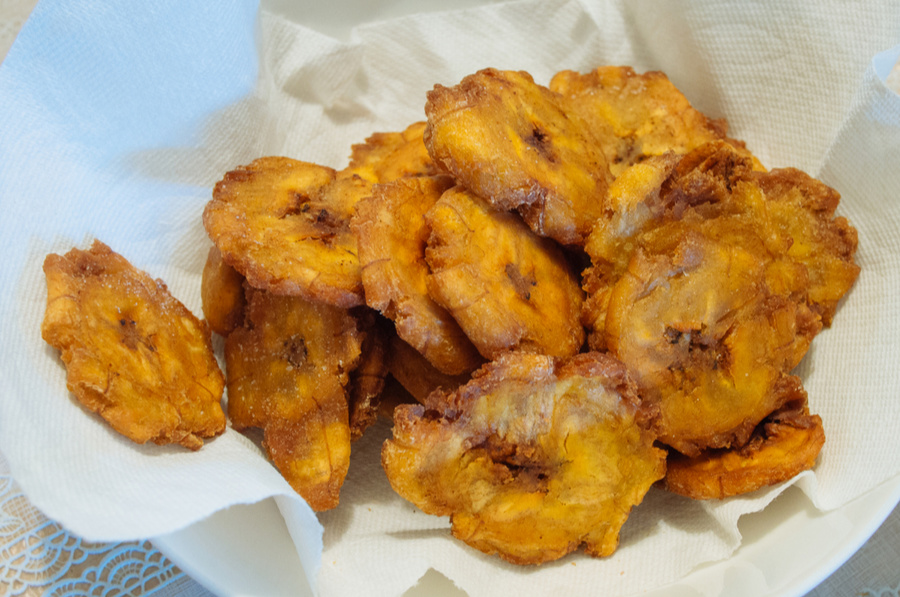
Puerto Rico
For a Puerto Rican, living in Los Angeles is not ideal in terms of food. There are almost no restaurants offering dishes from the island. That is why I have compiled a list of easy to make recipes that take me back home in a whim (I leave more complicated preparations for weekends or special occasions). Here I am sharing some of my favorites.
I think all Puerto Ricans have a special place on their heart for tostones (called patacones in other countries). This treat is prepared by double frying pieces of green plantains. They can be eaten by themselves (sprinkled with a bit of salt), with garlic sauce (mojo) or a combination of mayonnaise and ketchup.
Tostones are prepared by cutting a green plantain into pieces and frying those pieces. When the pieces are tender, they are taken out from the oil, smashed and fried again until crispy.
Plantain canoes are another dish I love to prepare. In this case, ripe plantains are used. A long cut is made to the plantains (slightly ripe, not that soft). Then, they are fried or baked. Once done, they are stuffed with ground beef, sprinkled with cheddar (or mozzarella) and baked until golden. I like to eat them with rice or a green salad. This is a great meal for a weeknight dinner.
Another dish we Puerto Ricans adore is tembleque. This coconut dessert is easy to make and can be shared in gatherings and potluck.
To prepare, combine coconut milk, sugar, cornstarch and salt in a pan and bring to a boil. Stir constantly until it thickens. Then, move the mix to a flat mold, sprinkle with ground cinnamon, and refrigerate overnight. It can also be refrigerated on individual molds.
I hope these dishes have piqued your interest in Puerto Rican cuisine. There is a lot to try and enjoy.
Ruth from Tanama Tales

Australia
Today Australia has a multi-cultural population and a food culture that embraces dishes from many different countries. Aussies love to eat a variety of international food including Asian, Indian, African and European. Founded as a penal colony of England, Australian food was initially the same as English, Scottish and Irish.
Meat Pies from Australia
Meat Pies originated back in those pioneer days and are still popular today. The pie filling is pre-cooked and encased in a base of shortcrust pastry covered with a lid of puff pastry.
Bakeries sell meat pies and Supermarkets stock a huge variety in frozen multipacks.
Every pie lover, of which I am one, has their favourite local pie shop and on Australian road trips I try the pies in as many country towns as possible. Bakeries often lay claim to the “Best Pie in Australia” and indeed there are National Pie Making Competitions held yearly.
To easily make a meat pie at home, use left over curry or thickened meat stew for the filling and sheets of frozen shortcrust and puff pastry from the Supermarket. Why not make more than required and freeze some for later.
Lamingtons from Australia
The Lamington is another classic Australian Food. This rectangular/square slice of sponge cake is first dipped in a runny chocolate before being rolled in desiccated coconut.
Lamingtons are quite messy to make at home and for this reason are a favourite fund-raiser for schools. Everyone loves to eat Lamingtons, but not so keen to make them.
Bakery lamingtons are quite substantial in size while smaller snack sized ones can be purchased in the Bakery Section at the Supermarket.
Lamingtons are often served on Australia Day.
Australian Drumstick Ice-creams
First made in the USA, Drumstick is a brand of individually wrapped ice-cream filled waffle cones with a sprinkling of nuts. Always popular with families, flavours are many ranging from the original Vanilla, through Choc Mint and Boysenberry to Affogato.
Australian firm “Peters” is the original manufacturer of the Australian Drumstick, and with 12% of Australians now being Vegan, a Vegan Option was added to the range in 2020.
Drumsticks in Australia can be purchased singly from cafes and corner stores or in four packs from the Supermarket.
Jan from Budget Travel Talk

